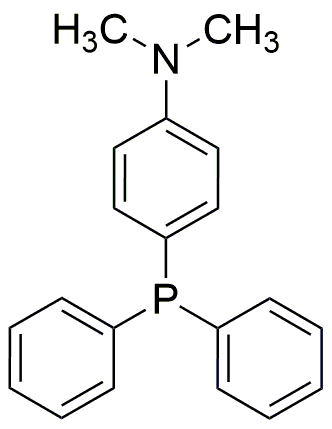4-(Dimethylamino)phenyldiphenylphosphine is widely utilized in research focused on:
- Catalysis: This compound serves as a ligand in various catalytic processes, enhancing reaction efficiency in organic synthesis, particularly in cross-coupling reactions.
- Pharmaceutical Development: Its unique properties make it valuable in drug design, helping to create more effective pharmaceutical compounds by improving bioavailability and targeting.
- Material Science: It is used in the development of advanced materials, including polymers and nanomaterials, due to its ability to modify surface properties and enhance conductivity.
- Analytical Chemistry: This chemical acts as a reagent in analytical methods, aiding in the detection and quantification of various substances in complex mixtures.
- Environmental Applications: It plays a role in developing sensors for detecting pollutants, contributing to environmental monitoring and protection efforts.
General Information
Properties
Safety and Regulations
Applications
4-(Dimethylamino)phenyldiphenylphosphine is widely utilized in research focused on:
- Catalysis: This compound serves as a ligand in various catalytic processes, enhancing reaction efficiency in organic synthesis, particularly in cross-coupling reactions.
- Pharmaceutical Development: Its unique properties make it valuable in drug design, helping to create more effective pharmaceutical compounds by improving bioavailability and targeting.
- Material Science: It is used in the development of advanced materials, including polymers and nanomaterials, due to its ability to modify surface properties and enhance conductivity.
- Analytical Chemistry: This chemical acts as a reagent in analytical methods, aiding in the detection and quantification of various substances in complex mixtures.
- Environmental Applications: It plays a role in developing sensors for detecting pollutants, contributing to environmental monitoring and protection efforts.
Documents
Safety Data Sheets (SDS)
The SDS provides comprehensive safety information on handling, storage, and disposal of the product.
Product Specification (PS)
The PS provides a comprehensive breakdown of the product’s properties, including chemical composition, physical state, purity, and storage requirements. It also details acceptable quality ranges and the product's intended applications.
Certificates of Analysis (COA)
Search for Certificates of Analysis (COA) by entering the products Lot Number. Lot and Batch Numbers can be found on a product’s label following the words ‘Lot’ or ‘Batch’.
Número de catálogo
Número de lote/lote
Certificates Of Origin (COO)
This COO confirms the country where the product was manufactured, and also details the materials and components used in it and whether it is derived from natural, synthetic, or other specific sources. This certificate may be required for customs, trade, and regulatory compliance.
Número de catálogo
Número de lote/lote
Safety Data Sheets (SDS)
The SDS provides comprehensive safety information on handling, storage, and disposal of the product.
DownloadProduct Specification (PS)
The PS provides a comprehensive breakdown of the product’s properties, including chemical composition, physical state, purity, and storage requirements. It also details acceptable quality ranges and the product's intended applications.
DownloadCertificates of Analysis (COA)
Search for Certificates of Analysis (COA) by entering the products Lot Number. Lot and Batch Numbers can be found on a product’s label following the words ‘Lot’ or ‘Batch’.
Número de catálogo
Número de lote/lote
Certificates Of Origin (COO)
This COO confirms the country where the product was manufactured, and also details the materials and components used in it and whether it is derived from natural, synthetic, or other specific sources. This certificate may be required for customs, trade, and regulatory compliance.


